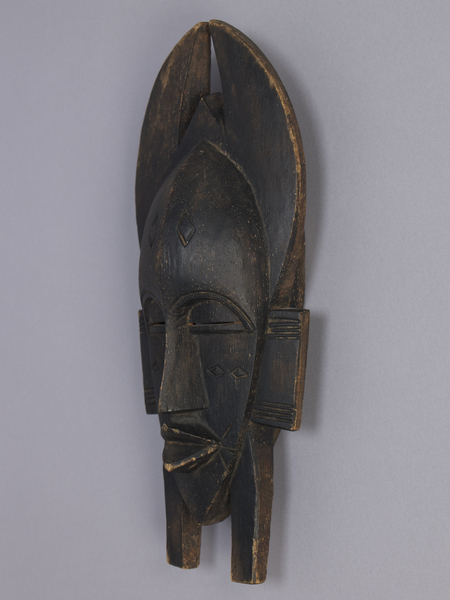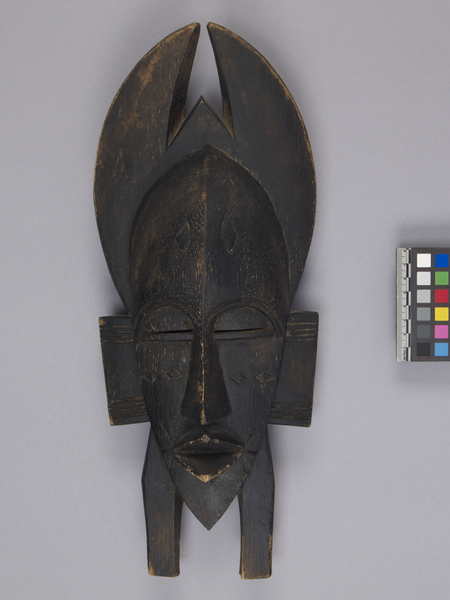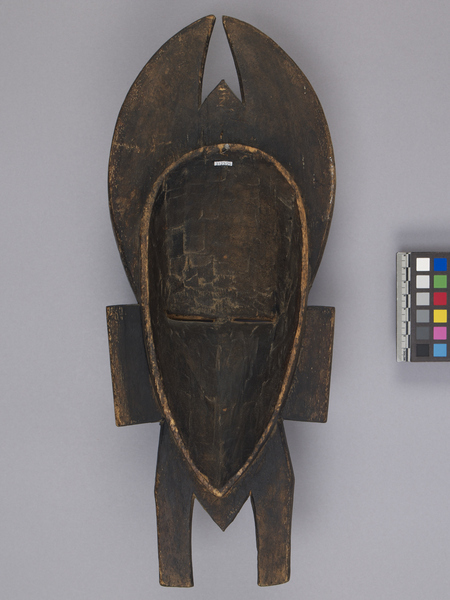Mask Item Number: 3123/25 from the MOA: University of British Columbia




Description
Carved wooden mask. Face is long with a pointed chin, widening toward the rounded forehead. A ridge runs the length of the forehead and meets the bridge of a sharp nose. Lips are rectangular and protrude. Eyes are narrow slits cut through the wood, inset, and framed by delicate lids and brow. Diamond shapes are carved into the forehead and cheeks. Two small legs(?) are connected to the chin, large rectangular ears sit alongside the cheeks, and large, wide horns curve above the forehead. The back of the mask is concave.
History Of Use
Kpelié (face masks) are idealized representations of the beauty of young women; they are used in funerary and initiation rites. Funerary masquerades, organized and performed by the Poro society of a given village, concentrate on honouring the dead and ensuring continuity between the living and the ancestral dead. Within the Fonombele blacksmith group, the Kodöli-yëhë masquerade dance utilizes these face masks in conjunction with specific hip and shoulder movements meant to refer to the feminine qualities of a beautiful young woman. Kodöli-yëhë serves as both entertainment in blacksmith funeral social festivities and as part of the initiation process for male Junior Grade members in blacksmith Poro societies. Kpelié are worn with raffia costumes and the dance is accompanied by songs, chants, and instruments. Until it's independence in 1960, Cote d'Ivoire remained under French rule and its policy of association. Indigenous Senfuo groups were allowed to preserve their customs so long as they were compatible with French interests. However, following mass conversions to Christianity in southern Cote d'Ivoire in the early 20th century and the Massa iconoclast movement in southern Mali in the mid-20th century many indigenous groups abandoned traditinal visual culture. What was left behind was either either collected or later replicated by Senufo artists for the art trade market.
Iconographic Meaning
The three lines that fan out from the corner of each side of the mouth are elemental motifs incised on every child, both male and female. This scarification (yegi kabaara, or “face scars”) identifies the person as Senufo. The diamond-shaped incisions on the forehead and cheeks symbolize a woman or a married woman.
Item History
- Made in Cote d'Ivoire ? or Mali ?
- Owned by Cornelia Hahn Oberlander before July 22, 2015
- Received from Cornelia Hahn Oberlander (Donor) on July 22, 2015
What
Who
- Culture
- Senufo ?
- Previous Owner
- Cornelia Hahn Oberlander
- Received from
- Cornelia Hahn Oberlander (Donor)
Where
- Holding Institution
- MOA: University of British Columbia
- Made in
- Cote d'Ivoire ? or Mali ?
When
- Ownership Date
- before July 22, 2015
- Acquisition Date
- on July 22, 2015
Other
- Condition
- good
- Accession Number
- 3123/0025